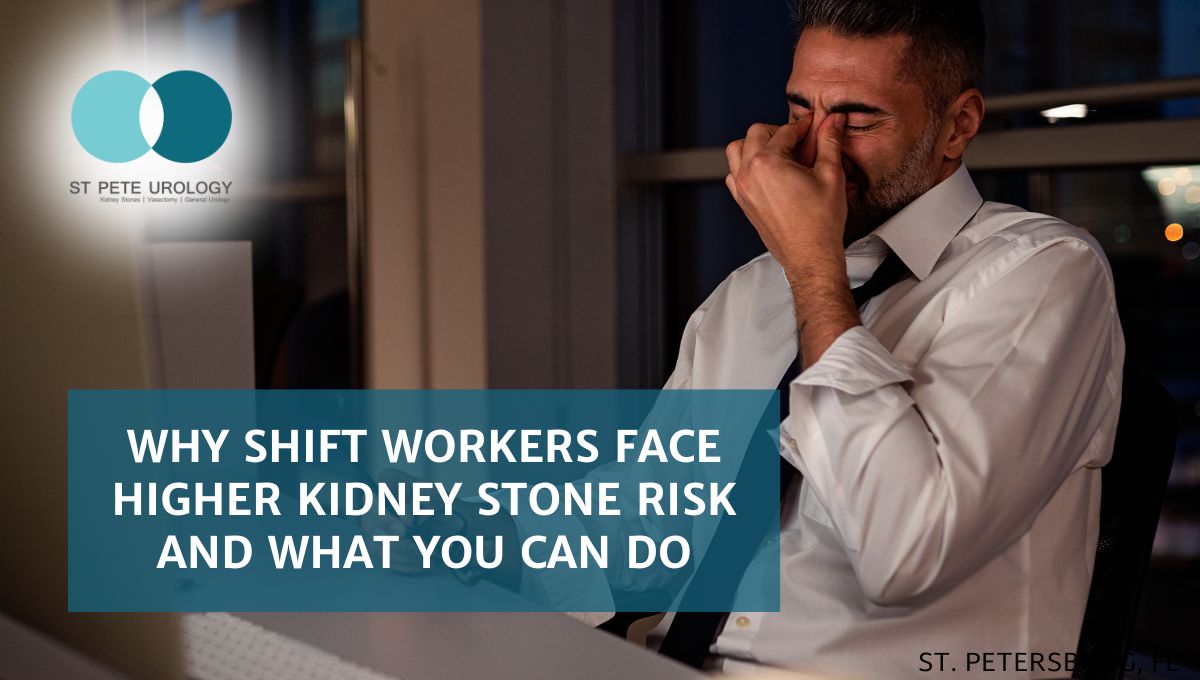3 Key Takeaways:
- Shift workers face 15-22% higher kidney stone risk due to circadian rhythm disruption that affects water balance and kidney chemistry, with night shift workers experiencing the greatest increase.
- Multiple lifestyle factors compound the risk including inadequate hydration, poor sleep quality, high BMI, limited physical activity, and smoking—all more prevalent among shift workers than day workers.
- Prevention requires comprehensive lifestyle changes focusing on aggressive hydration (2.5+ liters of urine daily), sleep optimization, weight management, regular exercise, and dietary modifications that can significantly reduce stone formation risk despite irregular work schedules.
 Shift workers have a 15-22% higher risk of developing kidney stones compared to those with regular daytime schedules. A groundbreaking study published in Mayo Clinic Proceedings analyzed data from over 220,000 participants and revealed that night shift workers face the highest risk—a sobering 22% increase—particularly among younger workers and those in sedentary desk jobs.
Shift workers have a 15-22% higher risk of developing kidney stones compared to those with regular daytime schedules. A groundbreaking study published in Mayo Clinic Proceedings analyzed data from over 220,000 participants and revealed that night shift workers face the highest risk—a sobering 22% increase—particularly among younger workers and those in sedentary desk jobs.
Understanding this connection matters because kidney stones affect up to one in eight Americans and can cause severe pain, missed work days, and long-term health complications. If you work irregular hours, learning how shift work impacts kidney stone formation empowers you to take proactive steps toward prevention.
Understanding the Connection Between Shift Work and Kidney Stones
The link between shift work and kidney stones extends beyond simple coincidence. Researchers tracked nearly 2,900 participants who developed kidney stones over a median follow-up period of 14 years. People working any shift outside standard 9-to-5 hours showed a 15% increased risk, while those who usually or always worked night shifts faced a 19% higher risk.
Night shift workers—especially those under 50 and in low-manual-labor jobs—experienced the most pronounced increase at 22%. This pattern suggests that when your work schedule conflicts with your body’s natural rhythms, your kidneys pay the price. What causes kidney stones involves multiple factors, but shift work has emerged as a significant environmental trigger that demands attention.
The Science Behind Circadian Rhythm Disruption and Stone Formation
Your body’s internal clock—known as circadian rhythms—governs critical processes including water balance and mineral regulation. When shift work disrupts these rhythms, it affects how your kidneys function. Dr. Felix Knauf from Mayo Clinic explains that your biological clock helps regulate systems controlling water balance and body chemistry, which directly impacts stone formation.
Circadian disruption alters metabolism and hormone secretion in ways that create conditions favorable for kidney stones. Your body struggles to maintain proper fluid balance when sleeping and working at unconventional hours. This disruption leads to concentrated urine—a primary risk factor for stone development. Understanding kidney stone risk factors helps shift workers recognize why their work schedule affects their urological health.
Key Risk Factors for Shift Workers
Beyond circadian disruption, shift workers face several compounding risk factors:
Inadequate hydration tops the list. Workers often reduce fluid intake to minimize bathroom breaks during night shifts, leading to concentrated urine where minerals crystallize more easily. According to the National Kidney Foundation, people producing 2 to 2.5 liters of urine daily were 50% less likely to develop kidney stones than those producing less.
Poor sleep quality affects metabolism and increases inflammation throughout your body, including your kidneys. Night shift workers typically sleep fewer hours and experience lower sleep quality than day workers, creating a cascade of health problems.
High body mass index (BMI) changes acid levels in urine, promoting stone formation. Shift work correlates with higher obesity rates due to disrupted eating patterns and reduced physical activity opportunities.
Limited physical activity during overnight hours means fewer opportunities for exercise. Movement helps prevent stone formation by promoting healthy metabolism and fluid circulation.
Smoking prevalence runs higher among shift workers, and tobacco use significantly increases kidney stone risk through multiple mechanisms including inflammation and altered kidney function.
These factors don’t operate in isolation—they compound each other. A sedentary night shift worker who smokes, drinks insufficient water, and sleeps poorly faces dramatically elevated risk. At St. Pete Urology, our board-certified urologists specialize in helping patients understand and manage these interconnected risk factors.
Proven Prevention Strategies for Night Shift Workers
You can significantly reduce your kidney stone risk with targeted lifestyle modifications:
Prioritize hydration above all else. Aim for at least 2.5 liters (85 ounces) of urine output daily, which requires drinking approximately 3 liters (100 ounces) of fluid. Keep a large water bottle at your workstation and set hourly reminders. As the National Institute of Diabetes and Digestive and Kidney Diseases (NIDDK) emphasizes, clear or pale yellow urine indicates proper hydration—dark urine signals you need more fluids immediately.
Optimize your sleep habits despite irregular hours. Create a dark, quiet sleeping environment during daytime hours using blackout curtains and white noise. Maintain consistent sleep schedules even on days off to stabilize your circadian rhythms as much as possible. Quality sleep reduces inflammation and helps your body maintain proper kidney function.
Maintain healthy weight through strategic meal planning. Prepare nutritious meals rather than relying on vending machines or fast food during night shifts. Focus on whole foods rich in kidney-healthy nutrients including fruits, vegetables, and adequate calcium from dietary sources.
Stay physically active by scheduling exercise as deliberately as you schedule work shifts. Even short walks during breaks help maintain metabolism and prevent stone formation. Regular physical activity reduces multiple kidney stone risk factors simultaneously.
Quit smoking if you currently use tobacco. Smoking cessation benefits extend far beyond kidney health, but eliminating this risk factor particularly helps shift workers already facing elevated stone risk. Resources exist to help—ask your healthcare provider about smoking cessation programs.
Monitor your diet by limiting sodium to 2-3 grams daily and avoiding excessive animal protein. Increase citrus fruit consumption, as citrate naturally inhibits stone formation. Contrary to popular belief, adequate dietary calcium (1,000-1,200 mg daily) actually prevents stones rather than causing them.
Schedule regular checkups with a urologist, especially if you experience symptoms like flank pain, blood in urine, or frequent urinary tract infections. Early detection and intervention prevent complications. The experienced physicians at St. Pete Urology—including Dr. Reid Graves, Dr. Nicholas Laryngakis, Dr. Adam Oppenheim, and Dr. Ankur Shah—provide comprehensive kidney stone prevention and treatment tailored to your unique circumstances.
Take Control of Your Kidney Health Today
Shift work’s 15-22% increased kidney stone risk represents a serious health concern, but it’s not inevitable. Understanding how circadian disruption, inadequate hydration, poor sleep, and other lifestyle factors combine to elevate risk empowers you to make informed choices. The strategies outlined above—prioritizing hydration, optimizing sleep, maintaining healthy weight, staying active, and working with skilled urologists—can dramatically reduce your risk even with irregular work schedules.
Don’t wait for painful symptoms to take action. If you work night shifts or irregular hours, contact St. Pete Urology at (727) 478-1172 to schedule a consultation. Our board-certified urologists serve the St. Petersburg, Tampa, and Clearwater communities with compassionate, evidence-based care. Let us help you develop a personalized prevention strategy that fits your lifestyle and protects your kidney health for years to come.
References:
- He, W., Yang, Y., Li, Y., Chen, J., & Wang, L. (2025). Lifestyle Factors in the Association of Shift Work with Kidney Stone Events. Mayo Clinic Proceedings, 100(10), 1-12. https://www.mayoclinicproceedings.org/article/S0025-6196(25)00222-8/fulltext
- National Kidney Foundation. (2025). Kidney Stones. Retrieved October 2, 2025, from https://www.kidney.org/kidney-topics/kidney-stones
- National Institute of Diabetes and Digestive and Kidney Diseases. (2025). Kidney Stones. Retrieved October 2, 2025, from https://www.niddk.nih.gov/health-information/urologic-diseases/kidney-stones
- Borghi, L., Meschi, T., Amato, F., Briganti, A., Novarini, A., & Giannini, A. (1996). Urinary volume, water and recurrences in idiopathic calcium nephrolithiasis: A 5-year randomized prospective study. Journal of Urology, 155(3), 839-843. https://pubmed.ncbi.nlm.nih.gov/8583588/





